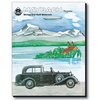Categories Model Car Manufacturer Tin Wizard 1936 Wanderer W25 Sport Roadster
Categories Model Car Manufacturer Ilario 1936 Horch 830 BL
Categories Vehicle Category One Off 1929 Audi Imperator Personal Car of Rasmussen
Categories Model Car Manufacturer Autopioneer 1938 Horch 830BL Woody Tarbuk
Categories Books Fahrzeugspuren in Chemnitz. Zur Historie des Fahrzeugbaues
Categories Books Fahrzeugspuren in Chemnitz: Fahrzeugschicksale
Categories Vehicle manufacturer Audi, Horch, Wanderer, Auto Union, DKW 1938 Auto Union Rekordwagen Bernd Rosemeyer
Categories Vehicle manufacturer Audi, Horch, Wanderer, Auto Union, DKW 1932 Porsche Wanderer Typ 8 Urach von Reutter
Categories Vehicle manufacturer Audi, Horch, Wanderer, Auto Union, DKW 1934 Horch 710 Spezial Roadster Reinbolt & Christé
Categories Vehicle manufacturer Audi, Horch, Wanderer, Auto Union, DKW 1934 Horch 710 Spezial Roadster Reinbolt & Christé
1936 Wanderer W25 Sport Roadster
Product no.: M43038-2
Still in stock
can be shipped within 1-3 days
179.95 €
Prices incl. VAT, plus delivery
The total price is based on the VAT of the recipient country, it will be adjusted accordingly at the checkout.
Available delivery methods: DHL standard delivery in Germany, DHL standard delivery to the EU, DHL Standard delivery outside Europe, DHL - Standard delivery to United Kingdom (UK) & Norway, DHL - Standard delivery to Switzerland
We also recommend
*
Prices incl. VAT, plus delivery
The total price is based on the VAT of the recipient country, it will be adjusted accordingly at the checkout.
Browse these categories as well: Tin Wizard, Audi, Horch, Wanderer, Auto Union, DKW, White Metal Model Cars
1936 Horch 830 BL
Product no.: IL117
Still in stock
can be shipped within 1-3 days
299.95 €
Prices incl. VAT, plus delivery
The total price is based on the VAT of the recipient country, it will be adjusted accordingly at the checkout.
We also recommend
*
Prices incl. VAT, plus delivery
The total price is based on the VAT of the recipient country, it will be adjusted accordingly at the checkout.
Browse these categories as well: Ilario, Audi, Horch, Wanderer, Auto Union, DKW, Home page
1929 Audi Imperator Personal Car of Rasmussen
Product no.: Autopioneer 06currently sold out
if you are interested, please contact: info@autopioneer.de
We also recommend
*
Prices incl. VAT, plus delivery
The total price is based on the VAT of the recipient country, it will be adjusted accordingly at the checkout.
Customers who bought this product also bought
|
|
1937 Borgward Hansa 1,5 l Windspiel
259.95 €
*
|
|
|
|
1949 Delahaye 163D by Duffau
529.95 €
*
|
*
Prices incl. VAT, plus delivery
The total price is based on the VAT of the recipient country, it will be adjusted accordingly at the checkout.
Browse these categories as well: One Off, Autopioneer, Audi, Horch, Wanderer, Auto Union, DKW, Joseph Neuss
1938 Horch 830BL Woody Tarbuk
Product no.: Autopioneer 07currently sold out
if you are interested, please contact: info@autopioneer.de
We also recommend
*
Prices incl. VAT, plus delivery
The total price is based on the VAT of the recipient country, it will be adjusted accordingly at the checkout.
Customers who bought this product also bought
|
|
1937 Borgward Hansa 1,5 l Windspiel
259.95 €
*
|
|
|
|
|
*
Prices incl. VAT, plus delivery
The total price is based on the VAT of the recipient country, it will be adjusted accordingly at the checkout.
Browse these categories as well: Autopioneer, Audi, Horch, Wanderer, Auto Union, DKW, Tarbuk
Fahrzeugspuren in Chemnitz. Zur Historie des Fahrzeugbaues
Product no.: 9783937654775
Still in stock
can be shipped within 1-3 days
24.90 €
Prices incl. VAT, plus delivery
The total price is based on the VAT of the recipient country, it will be adjusted accordingly at the checkout.
Fahrzeugspuren in Chemnitz: Fahrzeugschicksale
Product no.: 9783937654966
Still in stock
can be shipped within 1-3 days
24.90 €
Prices incl. VAT, plus delivery
The total price is based on the VAT of the recipient country, it will be adjusted accordingly at the checkout.
1938 Auto Union Rekordwagen Bernd Rosemeyer
Product no.: GB 3
Still in stock
can be shipped within 1-3 days
149.95 €
Prices incl. VAT, plus delivery
The total price is based on the VAT of the recipient country, it will be adjusted accordingly at the checkout.
1932 Porsche Wanderer Typ 8 Urach von Reutter
Product no.: Autopioneer 10
Still in stock
can be shipped within 1-3 days
259.95 €
Prices incl. VAT, plus delivery
The total price is based on the VAT of the recipient country, it will be adjusted accordingly at the checkout.
We also recommend
*
Prices incl. VAT, plus delivery
The total price is based on the VAT of the recipient country, it will be adjusted accordingly at the checkout.
Customers who bought this product also bought
|
|
1937 Borgward Hansa 1,5 l Windspiel
259.95 €
*
|
|
|
|
|
*
Prices incl. VAT, plus delivery
The total price is based on the VAT of the recipient country, it will be adjusted accordingly at the checkout.
Browse these categories as well: Audi, Horch, Wanderer, Auto Union, DKW, Autopioneer, Home page, Reutter
1934 Horch 710 Spezial Roadster Reinbolt & Christé
Product no.: Il126
Still in stock
can be shipped within 1-3 days
299.95 €
Prices incl. VAT, plus delivery
The total price is based on the VAT of the recipient country, it will be adjusted accordingly at the checkout.
1934 Horch 710 Spezial Roadster Reinbolt & Christé
Product no.: Il127
Still in stock
can be shipped within 1-3 days
299.95 €
Prices incl. VAT, plus delivery
The total price is based on the VAT of the recipient country, it will be adjusted accordingly at the checkout.



































































